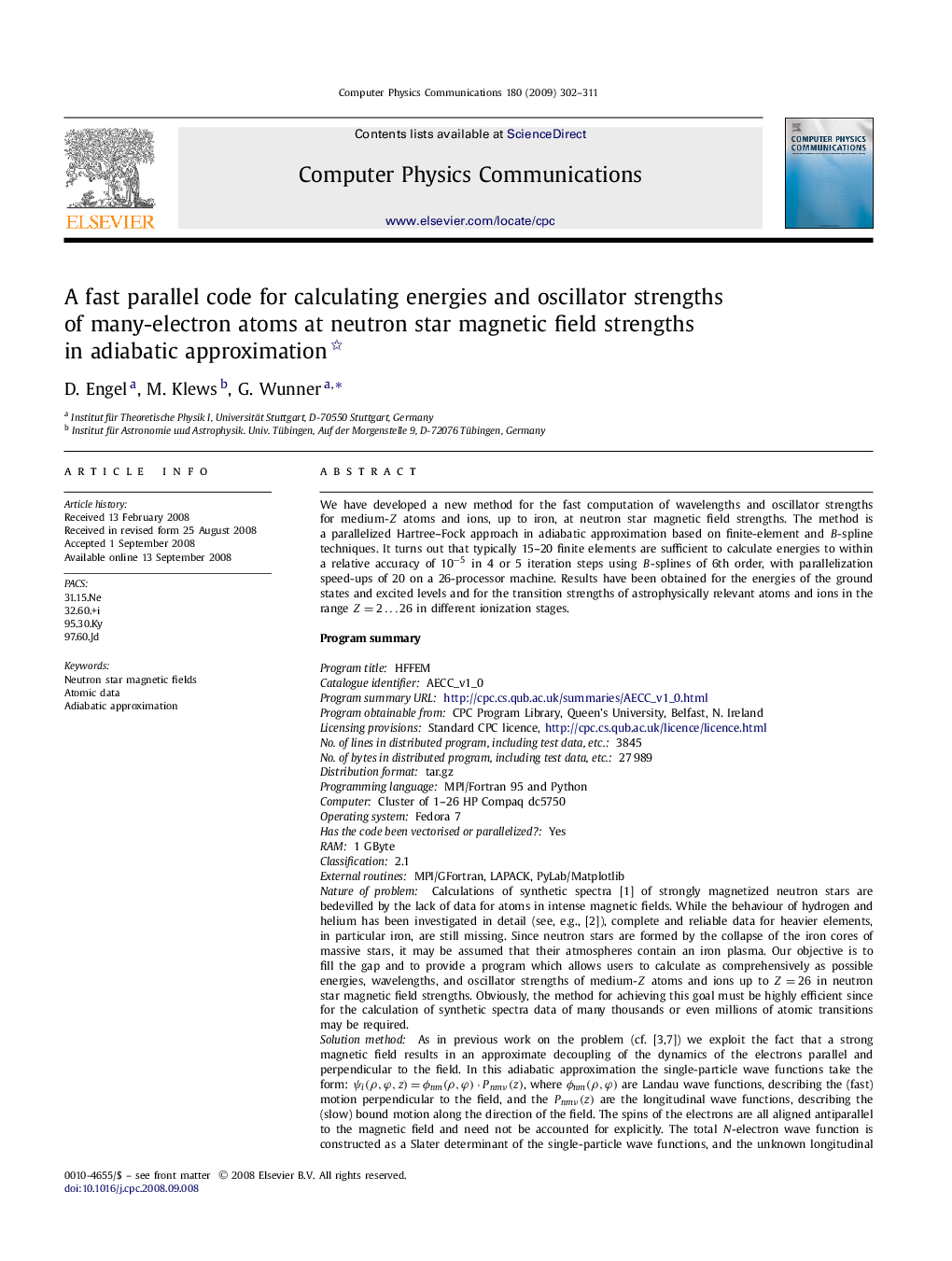| کد مقاله | کد نشریه | سال انتشار | مقاله انگلیسی | نسخه تمام متن |
|---|---|---|---|---|
| 502183 | 863687 | 2009 | 10 صفحه PDF | دانلود رایگان |

We have developed a new method for the fast computation of wavelengths and oscillator strengths for medium-Z atoms and ions, up to iron, at neutron star magnetic field strengths. The method is a parallelized Hartree–Fock approach in adiabatic approximation based on finite-element and B-spline techniques. It turns out that typically 15–20 finite elements are sufficient to calculate energies to within a relative accuracy of 10−5 in 4 or 5 iteration steps using B -splines of 6th order, with parallelization speed-ups of 20 on a 26-processor machine. Results have been obtained for the energies of the ground states and excited levels and for the transition strengths of astrophysically relevant atoms and ions in the range Z=2…26Z=2…26 in different ionization stages.Program summaryProgram title: HFFEMCatalogue identifier: AECC_v1_0Program summary URL:http://cpc.cs.qub.ac.uk/summaries/AECC_v1_0.htmlProgram obtainable from: CPC Program Library, Queen's University, Belfast, N. IrelandLicensing provisions: Standard CPC licence, http://cpc.cs.qub.ac.uk/licence/licence.htmlNo. of lines in distributed program, including test data, etc.: 3845No. of bytes in distributed program, including test data, etc.: 27 989Distribution format: tar.gzProgramming language: MPI/Fortran 95 and PythonComputer: Cluster of 1–26 HP Compaq dc5750Operating system: Fedora 7Has the code been vectorised or parallelized?: YesRAM: 1 GByteClassification: 2.1External routines: MPI/GFortran, LAPACK, PyLab/MatplotlibNature of problem: Calculations of synthetic spectra [1] of strongly magnetized neutron stars are bedevilled by the lack of data for atoms in intense magnetic fields. While the behaviour of hydrogen and helium has been investigated in detail (see, e.g., [2]), complete and reliable data for heavier elements, in particular iron, are still missing. Since neutron stars are formed by the collapse of the iron cores of massive stars, it may be assumed that their atmospheres contain an iron plasma. Our objective is to fill the gap and to provide a program which allows users to calculate as comprehensively as possible energies, wavelengths, and oscillator strengths of medium-Z atoms and ions up to Z=26Z=26 in neutron star magnetic field strengths. Obviously, the method for achieving this goal must be highly efficient since for the calculation of synthetic spectra data of many thousands or even millions of atomic transitions may be required.Solution method: As in previous work on the problem (cf. [3,7]) we exploit the fact that a strong magnetic field results in an approximate decoupling of the dynamics of the electrons parallel and perpendicular to the field. In this adiabatic approximation the single-particle wave functions take the form: ψi(ρ,φ,z)=ϕnm(ρ,φ)⋅Pnmν(z)ψi(ρ,φ,z)=ϕnm(ρ,φ)⋅Pnmν(z), where ϕnm(ρ,φ)ϕnm(ρ,φ) are Landau wave functions, describing the (fast) motion perpendicular to the field, and the Pnmν(z)Pnmν(z) are the longitudinal wave functions, describing the (slow) bound motion along the direction of the field. The spins of the electrons are all aligned antiparallel to the magnetic field and need not be accounted for explicitly. The total N-electron wave function is constructed as a Slater determinant of the single-particle wave functions, and the unknown longitudinal wave functions are determined from the Hartree–Fock equations, which follow from inserting the total N-electron wave function into Schrödinger's variational principle for the total energy. The novel feature of our approach [8] is to use finite-element and B-spline techniques to solve the Hartree–Fock equations for atoms in strong magnetic fields. This is accomplished through the following steps: 1) decomposition of the z-axis into finite elements with quadratically widening element borders; 2) sixth-order B-spline expansion of the single-particle wave functions on the individual finite elements; 3) formulation of the variational principle equivalent to the Hartree–Fock equations in terms of the expansion coefficients. This leads to a simple system of linear equations for the expansion coefficients, which is solved numerically, and, since the direct and exchange interaction potential terms depend on the wave functions, in a self consistent way. The iteration procedure is initialized by distributing the electrons on magnetic sublevels according to the level scheme of the hydrogen atom in intense magnetic fields. To speed up the calculations, the code is parallelized. The parallelization strategy is: a) each processor calculates one or several electrons, depending on the total number of processors, b) single-particle wave functions are broadcast from each processor to every other processor. As the coefficient vectors in the B -spline basis are small (dim≈20–25dim≈20–25), there is only little communication between the nodes. Typical speedups by a factor of 20 are obtained on a 26-processor cluster of HP Compaq dc57750.Running time: The test runs provided only require a few seconds using 2 processors.References:[1] K. Werner, S. Dreizler, The classical stellar atmosphere problem, in: H. Riffert, K. Werner (Eds.), Computational Astrophysics, Computational and Applied Mathematics, Elsevier, 1998.[2] H. Ruder, G. Wunner, H. Herold, F. Geyer, Atoms in Strong Magnetic Fields, Springer, Heidelberg, 1994.[3] P.B. Jones, Mon. Not. R. Astron. Soc. 216 (1985) 503.[4] D. Neuhauser, K. Langanke, S.E. Koonin, Phys. Rev. A 33 (1986) 2084.[5] M.C. Miller, D. Neuhauser, Mon. Not. R. Astron. Soc. 253 (1991) 107.[6] M. Rajagopal, R.W. Romani, M.C. Miller, Astrophys. J. 479 (1997) 347.[7] K. Mori, C.J. Hailey, Astrophys. J. 564 (2002) 914.[8] M. Klews, Discretization methods for the investigation of atoms in time dependent electric fields, and in extremely strong magnetic fields (in German), Doctoral Thesis, University of Tübingen, 2003, http://www.theo1.physik.unistuttgart. de/forschung/sfb382a15/klews2003.ps.gz.
Journal: Computer Physics Communications - Volume 180, Issue 2, February 2009, Pages 302–311